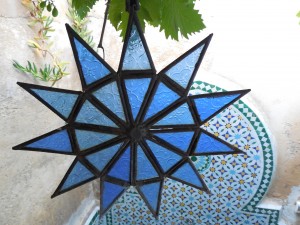 Literary works, in general, provide considerable insight about the structure of societies they emanate from as well as about individuals making up these societies. Morocco’s folk literature is revealing in this regard. Through judicious characterizations, well-knit plots and adequately-constructed settings, Moroccan writers, worthy of the name, would indeed reveal the rich linguistic and social variations of their society.
Literary works, in general, provide considerable insight about the structure of societies they emanate from as well as about individuals making up these societies. Morocco’s folk literature is revealing in this regard. Through judicious characterizations, well-knit plots and adequately-constructed settings, Moroccan writers, worthy of the name, would indeed reveal the rich linguistic and social variations of their society.
Rachida Rhazali’s ‘Hlali and Hlalia’ and ‘The Heritage’ folktales highlight but these variations. While the former story stresses the importance of idiolects variation in shaping social interactions between individuals within the same speech community, the latter emphasizes more the role of particular written texts in shaking the whole social structure of a close-knit little village.
Variation in idiolects (the language use characterizing individual speakers) among a speech community may shape the way these individuals socially interact. The socialization process of ‘Hlali and Hlalia’ folktale characters, and by ‘transfer’, members of the Moroccan society for that matter, is built upon individuals’ idiosyncratic speech. ‘Hlalia’, the story’s ‘female’ protagonist, displays a ‘demarcating’ idiolect. Her language is witty enough to make it hard to get to the ‘intended meaning’, even with her speech community members. Her ‘hidden messages’ must be inferred beyond the ‘surface’ reference of the literal vocabulary she uses. Some kind of ‘pragmatic competence’ is needed to understand her. A competence that many Moroccans and Hlali (the folktale’s ‘male’ protagonist), in particular, seem to possess and appraise. For instance, the dialogue between Hlali and Hlalia involving the ‘lettuce growing on marble’ and ‘the pregnant virgin’ showcases their mutual understanding and subsequent attractiveness. Actually, this ‘linguistic concord’ is revealed to be crucial in directing the complex relationships between her and her in-laws; that is, Hlali’s family. In effect, Hlalia’s shrewd idiolect causes her a near ‘social segregation’ vis-à-vis her family-in-law. For illustration, the episode where Hlalia requests for Hlali’s mother ‘to implicitly come in to the would-be daughter-in-law’s house’ demonstrates how ‘pragmatic misunderstanding’ can lead to animosity or even hatred. Fortunately enough, Hlalia and Hlali’s idiolects near-likeness is there to rescue the two social institutions at stake; namely- family and marriage.
In addition to idiolects, specific written texts may shake the entire social unity of a speech community as ‘tiny’ as a ‘Douar’ ( A typical small and ‘socially-cemented’ Moroccan village). ‘The heritage’ folktale displays a ‘social tremor’ brought about by a ‘piece of written words’, or will, in this small village. Indeed, the choice of a ‘Douar’ as the folktale setting place is a witted selection. The will’s content and its interpretation almost ‘dislocate’ the harmonious social ‘pieces’ this small village is made up of. Thus, the first social entity to ‘feel’ the tremor caused by the will’s language interpretation is ‘brotherhood’. Indeed, the ‘seemingly unfair’ distribution of the legacy the deceased mother left for her three sons, almost causes a break-up in a previously close and happy relationship between the brothers.
As a consequence, the brothers resort to other social groups among their community to try to resolve their dissent. Religious men, village people and neighbours are all involved. These very social groups are then the second in line to sense the ‘looming’ danger of disintegration the village may undergo, would the testament’s interpretation remain unresolved. In effect, the sense of community that prevails in the ‘Douar’ cannot stand, if the brothers and their respective wives persist in ‘fighting’ each other. Fortunately, the ‘sagacious old woman’ comes up with an adequate interpretation of the recommendation’s will: the brothers resort to ‘transcend’ the will’s apparent message, because they appear to identify the old woman with their late mother. This is how they decide to live in unison with each other, with their wives, with their neighbours and with all other social entities that constitute their tiny community. A unity among villagers that characterised ‘rural Morocco’ in the past, but which still does now nationwide.
In sum, linguistic and social variations within the Moroccan society are as rich and unifying as unexpected. The diversity and disparity of idiolects and social groups as evidenced by individuals living in ‘Douars’, villages, cities and megalopolises (Casablanca, for instance) help to build a multi-dialectal yet unique Moroccan nation. Social variables, such as age, gender, social status and ethnicity are to paste, rather than to implode, the compatibility of various social groups Morocco is constructed upon; a compatibility vitally needed for the continuity and prosperity of our society in these times of global uncertainty.
References:
– Kuhl, Joseph W. 2003. “The Idiolect, Chaos, And Language Custom Far From Equilibrium: Conversations in Morocco” A Dissertation Submitted to The Graduate Faculty of The University of Georgia, in Partial Fulfilment of the Requirements for the Ph. D. Degree, Athens.
– Rhazali, Rachida. 2007. “ Morocco’s Folktales: ‘Hlali and Hlalia’ pp100-103 and ‘The Heritage’pp 144-147” . Rabat, Dar Al qalam.







